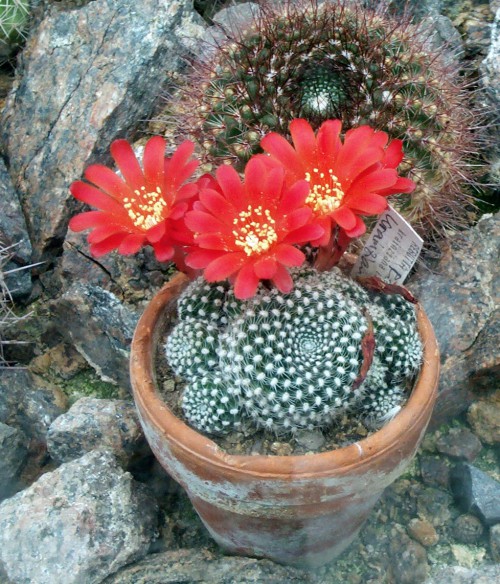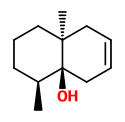Rebutia marsoneri Werderm. - syn.Rebutia krainziana Kesselr. - Cactaceae
Small globular (5-6cm) cactus, native to northern Argentina; flowers 3.5-4.5cm, orange-yellow or red, opened for 3 days, musty-earthy scented. https://de.wikipedia.org/wiki/Rebutia_marsoneri
„The 1,2,3,4,4a,5,8,8a-octahydro-4β8aα-dimethylnaphthalen-4aβ-ol (= dehydrogeosmin) has been identified as the olfactorily dominant compound in the flower scents of Rebutia marsoneri WERD., Dolichothele longimamma (DC.) BR. et R., and Sulcorebutia kruegeri…“
[1,2,3,4,4a,5,8,8a‐octahydro‐4β,8aα‐dimethylnaphthalen‐4aβ‐ol (= dehydrogeosmin), a novel compound occurring in the flower scent of various species of Cactaceae., Kaiser, R., Nussbaumer, C., Helvetica chimica acta, 73(1), 1990, 133-139]
Optically pure(+)-(4S,4aS,8aS)-1,2,3,4,4a,5,8,8a-octahydro-4,8a-dimethylnaphthalen-4a-ol, (+)-dehydrogeosmin, is released from flower heads of Rebutia marsoneri and Dolichothele spharica. The absolute configuration is identical with that of the known microbial product (−)-geosmin.
[Synthesis and Absolute Configuration of the C12‐Terpenoid Dehydrogeosmin from the Flower Scents of Rebutia marsoneri and Dolichothele sphaerica (Cactaceae); a new approach to bis‐angularly substituted trans‐decalins., Huber, U., Boland, W., König, W.A., Gehrcke, B., Helvetica chimica acta, 76(5), 1993, 1949-1955]
Farnesol is the precursor to dehydrogeosmin produced by R.marsoneri flowers.
[Biosynthesis of the Irregular C12‐Terpenoid Dehydrogeosmin in Flower Heads of Rebutia marsoneri WERD.(Cactaceae)., Feng, Z., Huber, U., Boland, W., Helvetica chimica acta, 76(7), 1993, 2547-2552]
The headspace of R.marsoneri flowers contained (+)-dehydrogeosmin (33.0%) and (-)-geosmin (0.01%).
[Kaiser, Roman. „Scents from rain forests.“ CHIMIA International Journal for Chemistry 54.6 (2000): 346-363]
Dehydrogeosmin (DHG) production was studied in six cacti genera: Echinopsis hybrid, Echinopsis
obrepanda, Gymnocalycium andreae, Gymnocalycium bruchii, Gymnocalycium bodenbenderianum ssp. intertextum,
Gymnocalycium monvillei, Mammillaria baumii, Mammillaria longimamma, Mammillaria surculosa, Parodia procera,
Parodia tuberculata, Rebutia arenacea, Rebutia fabrisii, Rebutia marsoneri, and Turbinicarpus pseudomacrochele ssp. krainzianus and was the main volatile of R.marsoneri and Gymnocalycium andreae flowers. In all DHG-producing plants studied, floral scents were emitted in a diurnal rhythm. „The emission rate studies of DHG in Rebutia fabrisii showed quantitative variation between individuals, despite the fact that these plants were maintained under identical conditions and the flowers were of the same developmental stage… The similarities of floral scent composition found in plants of different genera, as in some species of Gymnocalycium and Rebutia, give further indications that the odor bouquets of these cacti have no taxonomic value. Similar scent compositions more likely reflect convergent adaptations to the same pollinator groups…“
[Musty‐Earthy Scent in Cactus Flowers: Characteristics of Floral Scent Production in Dehydrogeosmin‐Producing Cacti., Schlumpberger, B.O., Jux, A., Kunert, M., Boland, W., Wittmann, D., International Journal of Plant Sciences, 165(6), 2004, 1007-1015]

Rebutia marsoneri Werderm. as Rebutia krainziana, author: J. Marusczyk, (PD, CC0)
https://en.wikipedia.org/wiki/Rebutia#/media/File:Rebutia_krainziana_2.jpg

